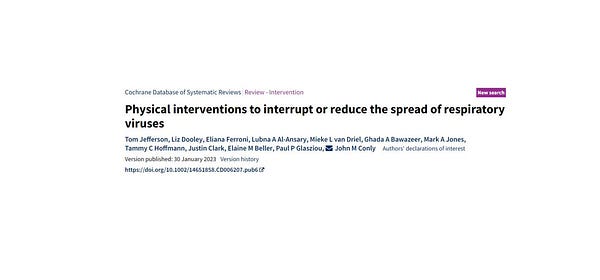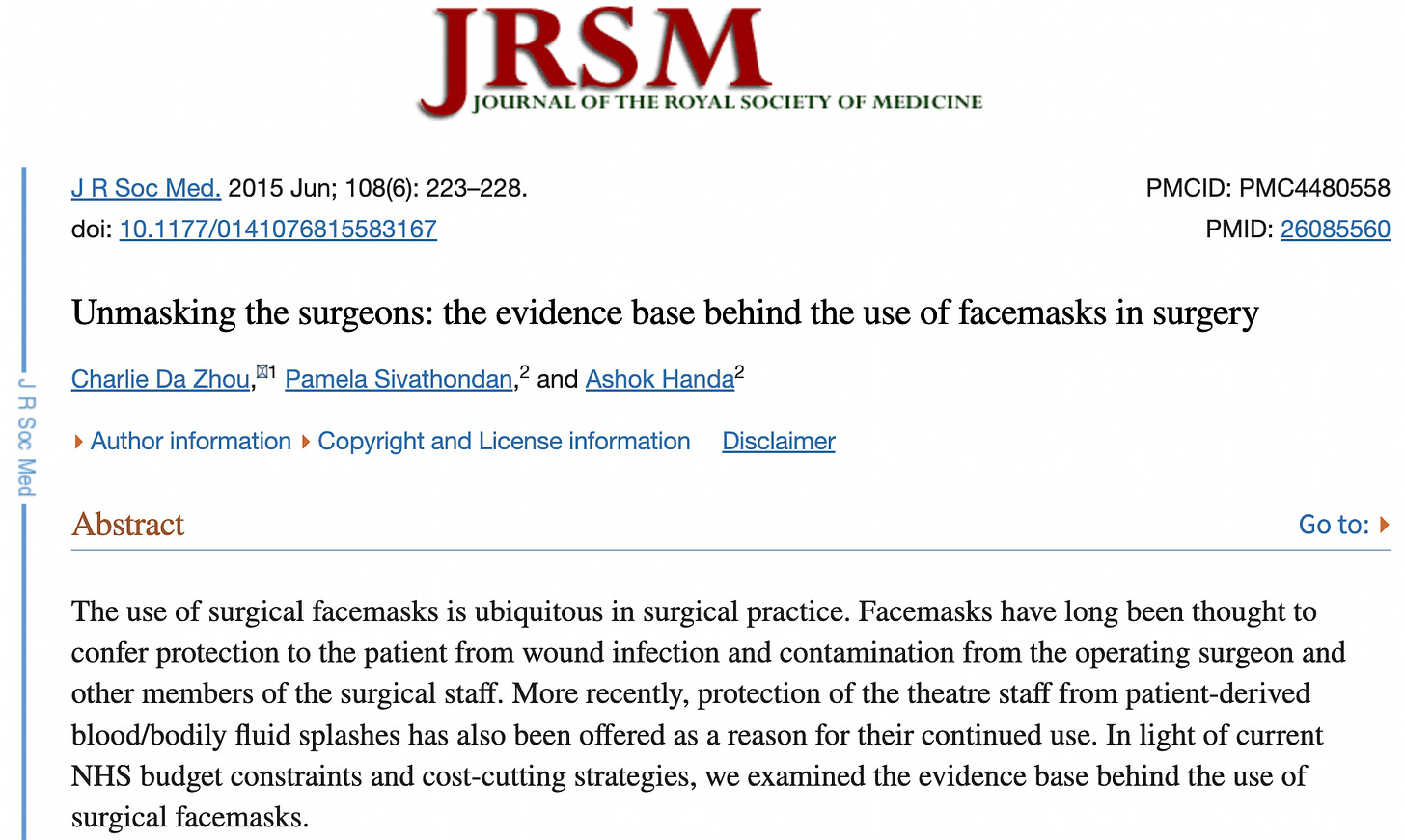The Cochrane Review on Masks
What does this mean about the last 3+ years of mandated "universal masking" in schools, hospitals, and nursing homes?
Cochrane - a Highly Respected Source of Medical Knowledge Since 1993
For those of you unaware, Cochrane (previously called the “Cochrane Collaboration”) is a nonprofit organization founded in 1993 and fairly quickly became the information gold standard in terms of it’s ability to aggregate and synthesize published clinical knowledge in an easily usable form.
I can personally tell you my colleagues use it frequently as a starting point for getting and staying current on the state of play in the medical literature - much akin to how Wikipedia is the trusted “starting point” for academic and scholarly research writ large. It’s highly respected, ubiquitous, and trusted.
Cochrane tends to specialize in meta-studies, and has been also on the forefront of refining the analytic approach of “meta-epidemiology,” according to a glowing report on the organization by editorial writers in a 2004 issue of the Canadian Medical Association Journal.
So - Cochrane is the shit, right?
The Cochrane Group Looks At Community Masking
Unless you’ve been living under a rock for the last few days, or you’re completely disconnected from #MedTwitter or are blissfully ignorant (living in an idyllic corner of Sweden or Florida) you may have heard about the recent release of the long-awaited update, “Do physical measures such as hand-washing or wearing masks stop or slow down the spread of respiratory viruses?” - which was recently published on the Cochrane website.
In it, they looked a 78 total studies, included because they were judged of sufficient quality and rigor, where influenza-like illness was studied (11 of the studies specifically looked at COVID-19) and found the following:
”The pooled results of RCTs did not show a clear reduction in respiratory viral infection with the use of medical/surgical masks. There were no clear differences between the use of medical/surgical masks compared with N95/P2 respirators in healthcare workers when used in routine care to reduce respiratory viral infection.
The language used, specifically, when summarizing the results of the meta-studies on both surgical (procedure) masks and N95s was the same: “little to no difference” found comparing people who used masks to controls (as an aside, handwashing did seem to show some effectiveness).
That’s it. We’re back to basically what was consensually understood about community masking, or what I’ve called ‘casual public masking,’ prior to 2019 - the understanding that was universal prior to the world going mad.
Essentially - everyone has had their time completely wasted for the last three-plus years.
Sorry!
‘No True Masking Study’
The main reaction from what I call collectively “Team Mask” - the various health bureaucrats & health officers and “influencers” on social media who have aggressively pushed mask mandates in schools, hospitals, and elsewhere for the past several years - has been minimization, and a dependence on what one could call the ‘No True Masking Study’ fallacy.
Obviously, this refers to the No True Scotsman Fallacy - which is defined as “an informal fallacy in which one attempts to protect their universal generalization from a falsifying counterexample by excluding the counterexample improperly.”
Seizing on the first line of the “Authors conclusions” section of the article, we see this position being taken by the regionally infamous county health officer from Washington State, Jeffrey Duchin:

Duchin’s tweet, of course, is in response to the 19-tweet monstrosity by the perpetually-averse-to-taking-controversial-positions-on-anything epidemiologist Dr. Jennifer Nuzzo:


I’ll save you the trouble. Essentially Nuzzo’s take is an extended, incredibly tiresome exposition, wondering out loud in obscurantist academic-speak why the 78 studies included in the Cochrane report didn’t yield any appreciable signal indicating effectiveness of community masking, and how really, what we needed to do was to figure out how to get people to comply with instructions to mask better.
Really.
Yeeeeahhh. That’s essentially my reaction.
Depressingly, the reaction from traditional media has been almost complete radio silence (I’d say it’s “surprising” but the last three years has made somewhat of a depressed cynic out of me).
Searching Google News under “Cochrane masks” I found three articles,
one from Bloomberg, titled neutrally as “Face Masks’ Ability to Stop Viruses Needs Study, Review Finds” (which contained an exceedingly bland report on the Cochrane study),
an article published on “The Conversation” (a publication I’d never heard from before today) by noted pro-lockdown and pro-mandate physician and epidemiologist, David Fisman, titled, a bit dizzyingly, “Yes, masks reduce the risk of spreading COVID, despite a review saying they don’t,”
and finally, one lone (but still quite brief) article by two Oxford professors (one of epidemiology and the other of EBM), titled, “Do mask mandates work?” - and actually does in my opinion a good job summarizing the main take-home message of the recent Cochrane update.
Cochrane Report means “Masks Don’t Work,” Right?
I want to first highlight a problem with Twitter (well, obviously, there are a lot of problems). Then, I want to tell a bit of a story about the “before times” - my nursing home, pre-COVID.
When it comes to the question of masks, I often hear the “mask debate” boiled down into two opposing sides - “masks don’t work,” or “masks work.”
The answer is, obviously (since you’re all appropriately nuanced, thinking people) is that neither of these things are true.
I’ve long talked about the scourge of “universal masking” policies in nursing homes. But the fact is, as annoying as these infernal things are - they do have their place.

Procedure masks - these things - are easy.
When I criticize (which I do - frequently) - universal masking policies and someone says “you wouldn’t want a surgeon to not wear them when they’re operating on you” - my response is - “of course not, I don’t want them to get wound backsplash in their face! Would you?”
I mean, that’s not very nice to them.
This, as an aside - is exactly what procedure masks are for, have been for, and nothing more, nothing less. They are, essentially, medical grade “splatter guards” worn for the surgeon’s hygiene and convenience (that, and arguably to maintain “theater discipline” - a fancy way to say they’re simply part of the surgery room uniform). Read more about it here:
N95 masks - also known as respirator masks - these are designed to filter small particles through a filter embedded in the mask.
The mask itself, unlike surgical or procedure masks - isn’t loose-fitting (therefore preventing the gaps on the sides that exist with surgical or cloth masks, where breath can “plume” off the sides and spray towards neighbors sitting beside you on a plane, bus, or classroom).
N95s, when used properly, are routinely fit-tested prior to use, are used by trained personnel, and under circumscribed situations (such as in isolation units around actively sick patients).
N95s are also supposed to be used under time-limited circumstances as well.
Why?
Here’s a thought for you - according to a heavily cited study, people touch their faces an average of 23 times per hour.
While I don’t have the figures about masked faces - I’m sure everyone has watched people touch masks, lower them, raise them, jostle them, etc. This goes for people wearing tight, uncomfortable respirator masks as well (and people who complain they’re comfortable have likely never actually worn them properly).
People can typically only wear N95 masks for short periods of time (say, as clinicians rounding on an isolation unit for a couple of hours maximum) before they break the seal.
Needless to say - no one in the community wears them that way outside of hospitals. And in the hospital system, outside of circumscribed, time-limited situations, even trained personnel aren’t significantly better.
“So what about the Cochrane Report? I know Masks Work! It’s Common Sense”
I’ve heard this a few times now. “It’s common sense!” Or “it’s physics!” (which is really the same as the “common sense” argument - as if the “physics” of the epidemiology of viral spread was like a simple ballistics problem).
Here’s my idea.
In the hospital environment (I’m a nursing home doc - so that’s my main concern) - common sense was the way we dealt with localized outbreaks of contagious illness prior to 2019.
We’ve had a number in my nursing home - mainly a couple of good, rip roaring rounds of flu, and a couple of rounds of norovirus (AKA stomach flu).
We created isolation units. We separated the sick from the well, we confined the sick to their quarters, and staff were instructed to wear full PPE when caring for the sick residents. For our norovirus patients, it was “gown and glove,” and for our flu patients, gown, glove, and mask.
After the illnesses were over - we were done. That’s it. That’s “common sense” to me.
For staff - if sick, we stayed home. When well - we worked. No masks, no PPE for healthy asymptomatic staff, and certainly never for any of our residents.
Prior to 2019 - asking a nursing home to mask was utter madness.
And for me - I’ve seen way too many old, frail, demented elderly people in reclining wheelchairs staring blankly at the ceiling as they chewed away at a sopping wet mask. Enough to last a lifetime.
Enough of all of this.










Thank you! Great analysis and couldn't agree more with your assessment of Dr. Jennifer Nuzzo, who was so great on school reopening and pretty consistently disappointing ever since.
Thanks for addressing the fit-testing. I’ve often wondered for how long they were validated to perform well. These people tweeting about how they contentedly wear their (non-fit-tested) N95s all day are just showing their ignorance.